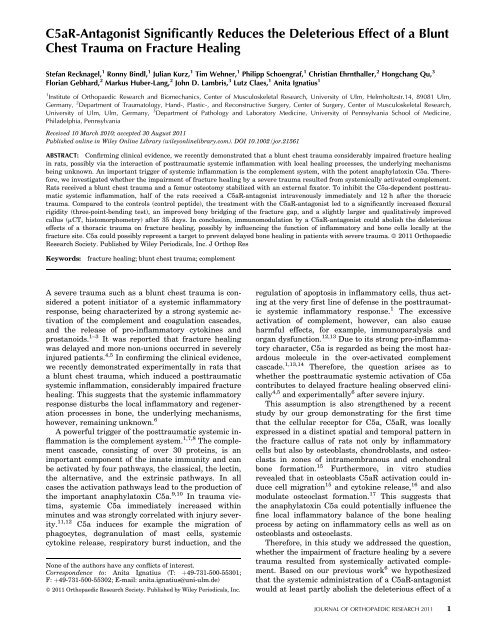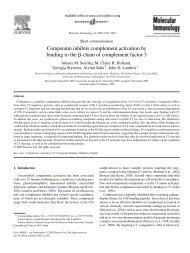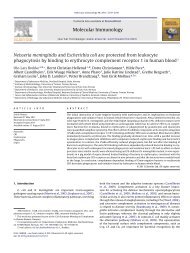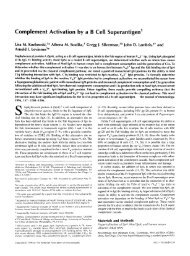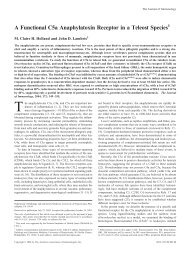C5aR-Antagonist Significantly Reduces the ... - John D. Lambris
C5aR-Antagonist Significantly Reduces the ... - John D. Lambris
C5aR-Antagonist Significantly Reduces the ... - John D. Lambris
You also want an ePaper? Increase the reach of your titles
YUMPU automatically turns print PDFs into web optimized ePapers that Google loves.
<strong>C5aR</strong>-<strong>Antagonist</strong> <strong>Significantly</strong> <strong>Reduces</strong> <strong>the</strong> Deleterious Effect of a Blunt<br />
Chest Trauma on Fracture Healing<br />
Stefan Recknagel, 1 Ronny Bindl, 1 Julian Kurz, 1 Tim Wehner, 1 Philipp Schoengraf, 1 Christian Ehrnthaller, 2 Hongchang Qu, 3<br />
Florian Gebhard, 2 Markus Huber-Lang, 2 <strong>John</strong> D. <strong>Lambris</strong>, 3 Lutz Claes, 1 Anita Ignatius 1<br />
1 Institute of Orthopaedic Research and Biomechanics, Center of Musculoskeletal Research, University of Ulm, Helmholtzstr.14, 89081 Ulm,<br />
Germany, 2 Department of Traumatology, Hand-, Plastic-, and Reconstructive Surgery, Center of Surgery, Center of Musculoskeletal Research,<br />
University of Ulm, Ulm, Germany, 3 Department of Pathology and Laboratory Medicine, University of Pennsylvania School of Medicine,<br />
Philadelphia, Pennsylvania<br />
Received 10 March 2010; accepted 30 August 2011<br />
Published online in Wiley Online Library (wileyonlinelibrary.com). DOI 10.1002/jor.21561<br />
ABSTRACT: Confirming clinical evidence, we recently demonstrated that a blunt chest trauma considerably impaired fracture healing<br />
in rats, possibly via <strong>the</strong> interaction of posttraumatic systemic inflammation with local healing processes, <strong>the</strong> underlying mechanisms<br />
being unknown. An important trigger of systemic inflammation is <strong>the</strong> complement system, with <strong>the</strong> potent anaphylatoxin C5a. Therefore,<br />
we investigated whe<strong>the</strong>r <strong>the</strong> impairment of fracture healing by a severe trauma resulted from systemically activated complement.<br />
Rats received a blunt chest trauma and a femur osteotomy stabilized with an external fixator. To inhibit <strong>the</strong> C5a-dependent posttraumatic<br />
systemic inflammation, half of <strong>the</strong> rats received a <strong>C5aR</strong>-antagonist intravenously immediately and 12 h after <strong>the</strong> thoracic<br />
trauma. Compared to <strong>the</strong> controls (control peptide), <strong>the</strong> treatment with <strong>the</strong> <strong>C5aR</strong>-antagonist led to a significantly increased flexural<br />
rigidity (three-point-bending test), an improved bony bridging of <strong>the</strong> fracture gap, and a slightly larger and qualitatively improved<br />
callus (mCT, histomorphometry) after 35 days. In conclusion, immunomodulation by a <strong>C5aR</strong>-antagonist could abolish <strong>the</strong> deleterious<br />
effects of a thoracic trauma on fracture healing, possibly by influencing <strong>the</strong> function of inflammatory and bone cells locally at <strong>the</strong><br />
fracture site. C5a could possibly represent a target to prevent delayed bone healing in patients with severe trauma. ß 2011 Orthopaedic<br />
Research Society. Published by Wiley Periodicals, Inc. J Orthop Res<br />
Keywords: fracture healing; blunt chest trauma; complement<br />
A severe trauma such as a blunt chest trauma is considered<br />
a potent initiator of a systemic inflammatory<br />
response, being characterized by a strong systemic activation<br />
of <strong>the</strong> complement and coagulation cascades,<br />
and <strong>the</strong> release of pro-inflammatory cytokines and<br />
prostanoids. 1–3 It was reported that fracture healing<br />
was delayed and more non-unions occurred in severely<br />
injured patients. 4,5 In confirming <strong>the</strong> clinical evidence,<br />
we recently demonstrated experimentally in rats that<br />
a blunt chest trauma, which induced a posttraumatic<br />
systemic inflammation, considerably impaired fracture<br />
healing. This suggests that <strong>the</strong> systemic inflammatory<br />
response disturbs <strong>the</strong> local inflammatory and regeneration<br />
processes in bone, <strong>the</strong> underlying mechanisms,<br />
however, remaining unknown. 6<br />
A powerful trigger of <strong>the</strong> posttraumatic systemic inflammation<br />
is <strong>the</strong> complement system. 1,7,8 The complement<br />
cascade, consisting of over 30 proteins, is an<br />
important component of <strong>the</strong> innate immunity and can<br />
be activated by four pathways, <strong>the</strong> classical, <strong>the</strong> lectin,<br />
<strong>the</strong> alternative, and <strong>the</strong> extrinsic pathways. In all<br />
cases <strong>the</strong> activation pathways lead to <strong>the</strong> production of<br />
<strong>the</strong> important anaphylatoxin C5a. 9,10 In trauma victims,<br />
systemic C5a immediately increased within<br />
minutes and was strongly correlated with injury severity.<br />
11,12 C5a induces for example <strong>the</strong> migration of<br />
phagocytes, degranulation of mast cells, systemic<br />
cytokine release, respiratory burst induction, and <strong>the</strong><br />
None of <strong>the</strong> authors have any conflicts of interest.<br />
Correspondence to: Anita Ignatius (T: þ49-731-500-55301;<br />
F: þ49-731-500-55302; E-mail: anita.ignatius@uni-ulm.de)<br />
ß 2011 Orthopaedic Research Society. Published by Wiley Periodicals, Inc.<br />
regulation of apoptosis in inflammatory cells, thus acting<br />
at <strong>the</strong> very first line of defense in <strong>the</strong> posttraumatic<br />
systemic inflammatory response. 1 The excessive<br />
activation of complement, however, can also cause<br />
harmful effects, for example, immunoparalysis and<br />
organ dysfunction. 12,13 Due to its strong pro-inflammatory<br />
character, C5a is regarded as being <strong>the</strong> most hazardous<br />
molecule in <strong>the</strong> over-activated complement<br />
cascade. 1,13,14 Therefore, <strong>the</strong> question arises as to<br />
whe<strong>the</strong>r <strong>the</strong> posttraumatic systemic activation of C5a<br />
contributes to delayed fracture healing observed clinically<br />
4,5 and experimentally 6 after severe injury.<br />
This assumption is also streng<strong>the</strong>ned by a recent<br />
study by our group demonstrating for <strong>the</strong> first time<br />
that <strong>the</strong> cellular receptor for C5a, <strong>C5aR</strong>, was locally<br />
expressed in a distinct spatial and temporal pattern in<br />
<strong>the</strong> fracture callus of rats not only by inflammatory<br />
cells but also by osteoblasts, chondroblasts, and osteoclasts<br />
in zones of intramembranous and enchondral<br />
bone formation. 15 Fur<strong>the</strong>rmore, in vitro studies<br />
revealed that in osteoblasts <strong>C5aR</strong> activation could induce<br />
cell migration 15 and cytokine release, 16 and also<br />
modulate osteoclast formation. 17 This suggests that<br />
<strong>the</strong> anaphylatoxin C5a could potentially influence <strong>the</strong><br />
fine local inflammatory balance of <strong>the</strong> bone healing<br />
process by acting on inflammatory cells as well as on<br />
osteoblasts and osteoclasts.<br />
Therefore, in this study we addressed <strong>the</strong> question,<br />
whe<strong>the</strong>r <strong>the</strong> impairment of fracture healing by a severe<br />
trauma resulted from systemically activated complement.<br />
Based on our previous work 6 we hypo<strong>the</strong>sized<br />
that <strong>the</strong> systemic administration of a <strong>C5aR</strong>-antagonist<br />
would at least partly abolish <strong>the</strong> deleterious effect of a<br />
JOURNAL OF ORTHOPAEDIC RESEARCH 2011 1
2 RECKNAGEL ET AL.<br />
blunt chest trauma on bone healing in a rat model.<br />
The <strong>C5aR</strong>-antagonist was applied after <strong>the</strong> thoracic<br />
trauma to prevent <strong>the</strong> immediate C5a-dependent systemic<br />
inflammation. The fracture healing outcome was<br />
investigated after 35 days.<br />
METHODS<br />
Animal Experiment<br />
The animal experiment was performed according to international<br />
regulations for <strong>the</strong> care and use of laboratory animals,<br />
and approved by <strong>the</strong> local ethical committee (Regierungspräsidium<br />
Tübingen, Germany). Sixteen male Wistar rats<br />
(weight 400–450 g; age 10–12 weeks) received a blunt chest<br />
trauma combined with a femur osteotomy that was stabilized<br />
with an external fixator. Then <strong>the</strong> animals received ei<strong>the</strong>r a<br />
<strong>C5aR</strong>-antagonist (n ¼ 8) or a control peptide (control group,<br />
n ¼ 8).<br />
Surgery and Blunt Chest Trauma<br />
Surgery was performed as described previously. 6,18 Briefly, a<br />
standardized osteotomy gap of 1 mm was created at <strong>the</strong><br />
mid-shaft of <strong>the</strong> right femur and fixated with a custom-made<br />
external fixator. The offset of <strong>the</strong> fixator block was 6 mm,<br />
resulting in an axial stiffness of 119 N/mm. 6 Immediately<br />
after surgery <strong>the</strong> rats received an additional blunt chest<br />
trauma under general anes<strong>the</strong>sia using a blast wave generator<br />
as previously described in detail. 1,19 This model allows a<br />
bilateral, isolated lung contusion by <strong>the</strong> application of a standardized<br />
single blast wave centered on <strong>the</strong> middle of <strong>the</strong> thorax<br />
and induces a reproducible transient systemic<br />
inflammation. 1,6 An analgesic (20 mg/kg, Tramal 1 , Gruenenthal<br />
GmbH, Aachen, Germany) was administered subcutaneously<br />
during <strong>the</strong> operation and was diluted in <strong>the</strong> drinking<br />
water (25 mg/L) for <strong>the</strong> first 3 days following surgery. Each<br />
animal was individually housed, given unrestricted access to<br />
food and monitored daily for infection and mobility.<br />
<strong>C5aR</strong>-<strong>Antagonist</strong><br />
Immediately after <strong>the</strong> blunt chest trauma, one group<br />
received a <strong>C5aR</strong>-antagonist (Ac-F[OPdChaWR]; PMX-53) at<br />
a dosage of 1 mg/kg intravenously into <strong>the</strong> penis vein. 20,21<br />
The injection was repeated 12 h after <strong>the</strong> trauma to prevent<br />
<strong>the</strong> C5a-dependent systemic inflammation, which was<br />
detectable during <strong>the</strong> first 12–24 h after <strong>the</strong> blunt chest<br />
trauma in rats. 1,6 Control animals received a peptide<br />
(Ac-F[OPdChaAdR]) with two changed amino acids, which<br />
does not have antagonistic activity and thus does not develop<br />
any biological effect at <strong>the</strong> same concentration and at <strong>the</strong><br />
same time points. 22<br />
Biomechanical Testing<br />
After 35 days <strong>the</strong> rats were sacrificed and <strong>the</strong> operated as<br />
well as <strong>the</strong> contralateral intact femora were explanted. Biomechanical<br />
testing was performed using a non-destructive,<br />
three-point bending test, as described previously. 6 Briefly,<br />
after removing <strong>the</strong> fixators, <strong>the</strong> distal end of each bone<br />
was potted in a cylinder using polymethylmethacrylate<br />
(Technovit 1 3040, Heraeus Kulzer GmbH, Wer<strong>the</strong>im,<br />
Germany) and fixed in a hinge joint whereas <strong>the</strong> proximal<br />
end of <strong>the</strong> femur rested on <strong>the</strong> bending support. A quasistatic<br />
load was applied in a three-point bending mode with a materials<br />
testing machine (1454, Zwick GmbH, Ulm, Germany)<br />
using a 500 N load cell (A.S.T. Angewandte System-Technik<br />
GmbH, Dresden, Germany) and <strong>the</strong> flexural rigidity (EI) was<br />
JOURNAL OF ORTHOPAEDIC RESEARCH 2011<br />
calculated from <strong>the</strong> slope of <strong>the</strong> force deflection curve. The<br />
absolute values of <strong>the</strong> operated femora were related to<br />
<strong>the</strong> contralateral values of <strong>the</strong> un-operated femora to<br />
eliminate individual differences.<br />
Micro-Computed Tomography<br />
The femora were scanned using a mCT scanning device<br />
(Skyscan 1172), operating at a peak voltage of 50 kV and<br />
200 mA at a resolution of 15 mm. The mineralized callus<br />
within <strong>the</strong> former osteotomy gap was segmented and <strong>the</strong><br />
total tissue volume and <strong>the</strong> bone volume fraction (BV/TV)<br />
were calculated by global thresholding to distinguish<br />
between mineralized and non-mineralized tissue. 23 The maximum<br />
moment of inertia was calculated based on <strong>the</strong> tissue<br />
area on <strong>the</strong> transversal slices in <strong>the</strong> fracture gap. The apparent<br />
modulus of elasticity was calculated as <strong>the</strong> flexural rigidity<br />
divided by <strong>the</strong> maximum moment of inertia. 24 According<br />
to <strong>the</strong> standard clinical evaluation of X-rays <strong>the</strong> number of<br />
bridged cortices per callus were evaluated in two planes at<br />
right angles to one ano<strong>the</strong>r by using an CT analyzing software<br />
(Data viewer, Skyscan, Kontich, Belgium). 25 The distal<br />
pin hole served as orientation for <strong>the</strong> exact positioning of <strong>the</strong><br />
specimens. At least three bridged cortices per callus were<br />
considered as a ‘‘healed fracture.’’ Two observers evaluated<br />
<strong>the</strong> cortical bridging independently in a blinded fashion.<br />
Histomorphometry<br />
After fixating <strong>the</strong> femora in buffered 4% formaldehyde <strong>the</strong>y<br />
were dehydrated with ethanol (40–100%) and embedded in<br />
methyl methacrylate (Merck KGaA, Darmstadt, Germany).<br />
Seventy micrometers longitudinal sections were prepared,<br />
which were cut in anterior–posterior direction of <strong>the</strong> right<br />
femur. The pin holes guaranteed <strong>the</strong> standardized orientation<br />
of <strong>the</strong> sections. Then <strong>the</strong> sections were stained with<br />
Paragon (Toluidin blue and Fuchsin; both Waldeck GmbH &<br />
Co KG, Münster, Germany), which stains fibrous tissue in<br />
blue, cartilage tissue in purple and mineralized matrix in<br />
white-yellow. In <strong>the</strong> former osteotomy gap <strong>the</strong> newly formed<br />
tissue was evaluated by using a light microscope (Leica<br />
DMI6000B) at a fivefold magnification. The amount of bone,<br />
cartilage and fibrous tissue was assessed by circumscribing<br />
<strong>the</strong> corresponding areas with image analysis software (Leica<br />
MMAF 1.4.0 Imaging System, Leica, Heerbrugg, Switzerland<br />
powered by MetaMorph 1 ).<br />
Statistical Analysis<br />
Results are presented as medians and interquartile ranges<br />
(IR). For statistical analysis, <strong>the</strong> software PASW Statistics<br />
18.0 (SPSS, Inc., Chicago, IL) was used. Differences between<br />
groups regarding flexural rigidity, mCT-parameters, and histomorphometrical<br />
data were calculated using a Mann–Whitney<br />
U-test, whereas differences between groups regarding<br />
<strong>the</strong> number of bridged cortices were calculated using <strong>the</strong><br />
Fisher exact test. The level of significance was p < 0.05.<br />
RESULTS<br />
Biomechanical Testing<br />
The treatment of <strong>the</strong> animals with <strong>the</strong> <strong>C5aR</strong>-antagonist<br />
after blunt chest trauma significantly increased<br />
<strong>the</strong> flexural rigidity (Ctrl: EI ¼ 46.54% (IR: 27.44);<br />
<strong>C5aR</strong>-Ag: EI ¼ 72.18% (IR: 66.50)) of <strong>the</strong> callus by<br />
about 55% compared to <strong>the</strong> control group, which<br />
received <strong>the</strong> control peptide (Fig. 1).
Figure 1. Flexural rigidity (EI) of <strong>the</strong> fracture callus of rats<br />
without (Control) or with treatment with a <strong>C5aR</strong>-antagonist<br />
immediately and 12 h after <strong>the</strong> blunt chest trauma; p < 0.05<br />
Micro-Computed Tomography<br />
The application of <strong>the</strong> <strong>C5aR</strong>-antagonist led to a<br />
tendency for higher total callus volume, maximum moment<br />
of inertia, and apparent modulus of elasticity.<br />
None of <strong>the</strong> parameters showed statistical significance<br />
compared to <strong>the</strong> control group (Table 1). The results<br />
might indicate a somewhat larger and qualitatively<br />
superior callus in <strong>the</strong> rats treated with <strong>the</strong> <strong>C5aR</strong>antagonist.<br />
Fur<strong>the</strong>rmore, <strong>the</strong> fracture callus of rats<br />
which received <strong>the</strong> <strong>C5aR</strong>-antagonist showed considerably<br />
more bridged cortices compared to <strong>the</strong> control<br />
group, even though this was not statistically significant<br />
(Table 2).<br />
Histomorphometry<br />
The histomorphometrical results confirmed <strong>the</strong> results<br />
of <strong>the</strong> mCT analysis showing a slightly increased callus<br />
with more bone in <strong>the</strong> <strong>C5aR</strong>-antagonist treated group<br />
(Fig. 2).<br />
DISCUSSION<br />
This study demonstrated that systemically activated<br />
complement significantly contributes to <strong>the</strong> impairment<br />
of bone healing observed after severe trauma. Our<br />
results revealed that <strong>the</strong> application of a <strong>C5aR</strong>antagonist<br />
during <strong>the</strong> initial phase of <strong>the</strong> posttraumatic<br />
inflammatory response abolished <strong>the</strong> deleterious<br />
effect of a blunt chest trauma on fracture healing in<br />
a rat model. This was reflected by a considerably<br />
<strong>C5aR</strong>-ANTAGONIST ENHANCES FRACTURE HEALING 3<br />
improved flexural rigidity of <strong>the</strong> fracture callus, a<br />
higher bony bridging between <strong>the</strong> fracture fragments<br />
and a slightly larger and qualitatively improved callus<br />
formation in <strong>the</strong> rats treated with <strong>the</strong> <strong>C5aR</strong>antagonist.<br />
In a previous study we showed that a blunt chest<br />
trauma significantly impaired fracture healing in <strong>the</strong><br />
same rat model. 6 The flexural rigidity of <strong>the</strong> healed<br />
femora was reduced by approximately 60% and a<br />
smaller callus with an inferior quality was formed<br />
compared to <strong>the</strong> control group, which did not receive a<br />
thoracic trauma. 6 We proposed that <strong>the</strong> complex systemic<br />
inflammatory response induced by <strong>the</strong> thoracic<br />
trauma disturbed fracture healing locally, <strong>the</strong> underlying<br />
mechanisms remaining unknown. 6 The rat blunt<br />
chest trauma model used in <strong>the</strong> present study is wellestablished<br />
and induces a reproducible and transient<br />
systemic inflammatory response. 1,26 Reflecting clinical<br />
data in polytraumatic patients, 12,13 Flierl et al. recently<br />
showed that <strong>the</strong> complement system, especially C5a,<br />
triggered <strong>the</strong> complex systemic inflammatory response<br />
in this experimental model by enhancing <strong>the</strong> systemic<br />
cytokine release as well as disturbing <strong>the</strong> neutrophil<br />
function. Neutrophils displayed an enhanced chemotactic<br />
activity, phagocytosis, and production of reactive<br />
oxygen species followed by prolonged functional<br />
defects. 1 Fur<strong>the</strong>rmore, <strong>the</strong> systemic administration of<br />
an anti-C5a antibody immediately after <strong>the</strong> blunt<br />
chest trauma decreased <strong>the</strong> systemic cytokine release<br />
as well as <strong>the</strong> number of circulating neutrophils, and<br />
enhanced neutrophil function. This suggests that antagonizing<br />
excessive C5a might improve <strong>the</strong> outcome<br />
of a blunt chest trauma. 1 To investigate whe<strong>the</strong>r <strong>the</strong><br />
systemic C5a increase is also responsible for <strong>the</strong> deleterious<br />
effects of <strong>the</strong> blunt chest trauma on bone healing<br />
we applied a specific <strong>C5aR</strong>-antagonist. 20,21<br />
Blocking of <strong>C5aR</strong> completely abolished <strong>the</strong> negative<br />
impact of <strong>the</strong> thoracic trauma on fracture healing, suggesting<br />
that C5a was one of <strong>the</strong> main players in this<br />
scenario. The flexural rigidity of <strong>the</strong> callus increased<br />
significantly in <strong>the</strong> <strong>C5aR</strong>-antagonist treated group and<br />
nearly reached <strong>the</strong> levels of <strong>the</strong> intact contralateral<br />
femur. The biomechanical results correlated with an<br />
improved bony bridging of <strong>the</strong> fracture gap. Fur<strong>the</strong>rmore,<br />
<strong>the</strong> callus of <strong>the</strong> <strong>C5aR</strong>-antagonist treated group<br />
and <strong>the</strong> apparent modulus of elasticity, describing <strong>the</strong><br />
mechanical quality of <strong>the</strong> newly formed callus, 24 were<br />
slightly increased. Histomorphometry also indicated a<br />
slightly increased amount of newly formed bone in <strong>the</strong><br />
Table 1. m-Computed Tomography Analysis of <strong>the</strong> Calli of Rats without (Control) or with Treatment<br />
with a <strong>C5aR</strong>-<strong>Antagonist</strong> after Blunt Chest Trauma<br />
Measure Control <strong>C5aR</strong>-<strong>Antagonist</strong><br />
Total callus volume (mm 3 ) 15.72 (IR: 6.35) 16.47 (IR: 7.75)<br />
BV/TV (%) 85.55 (IR: 11.15) 82.26 (IR: 21.89)<br />
Maximum moment of inertia (mm 4 ) 33.32 (IR: 26.60) 41.12 (IR: 36.93)<br />
Apparent modulus of elasticity (MPa) 2469.98 (IR: 5357.93) 6214.25 (IR: 6470.93)<br />
JOURNAL OF ORTHOPAEDIC RESEARCH 2011
4 RECKNAGEL ET AL.<br />
Table 2. Number of Bridged Cortices of <strong>the</strong> Calli Evaluated by m-Computed Tomography in Two Planes of Rats<br />
without (Control) or with Treatment with a <strong>C5aR</strong>-<strong>Antagonist</strong><br />
Group<br />
Number of Bridged Cortices<br />
0 1 2 3 4 Group<br />
Not Healed Healed<br />
<strong>C5aR</strong>-antagonist treated group. The radiological and<br />
histological results revealed that <strong>the</strong> predominant<br />
tissue in <strong>the</strong> fracture callus in both groups was newly<br />
formed bone, indicating that <strong>the</strong> healing process had<br />
widely progressed after a period of 35 days. Never<strong>the</strong>less,<br />
<strong>the</strong> differences between <strong>the</strong> <strong>C5aR</strong>-antagonist<br />
treated and <strong>the</strong> control group in <strong>the</strong> biomechanical<br />
outcome were still considerable. In ongoing studies<br />
earlier investigation time points are included to evaluate<br />
differences in callus composition during <strong>the</strong> course<br />
of healing.<br />
At present little is known about <strong>the</strong> role of C5a in<br />
fracture healing. It is well known that complement is<br />
locally activated after tissue injury, and is important<br />
for an adequate and effective inflammation, for example,<br />
by increasing vascular permeability, recruitment<br />
of leukocytes, lymphocyte activation, opsonization of<br />
pathogens, and clearance of necrotic and apoptotic<br />
tissues at <strong>the</strong> site of injury. 27,28 Local activation of<br />
complement might, <strong>the</strong>refore, play an essential role in<br />
bone regeneration, especially in <strong>the</strong> fracture hematoma<br />
and <strong>the</strong> early stages of bone healing where inflammatory<br />
cells are predominant. 29,30 This was confirmed<br />
by a recent study of our group demonstrating that<br />
<strong>C5aR</strong> was abundantly expressed by <strong>the</strong>se cells, but<br />
intriguingly also by osteoblasts, chondroblasts, and<br />
osteoclasts in zones of intramembranous and enchondral<br />
ossification. 15 This suggests that C5a may be essential<br />
for regular regeneration processes during all stages of<br />
fracture healing.<br />
After a blunt chest trauma systemic C5a is increased<br />
very rapidly and transiently. 1 Accordingly, we applied<br />
<strong>the</strong> <strong>C5aR</strong>-antagonist during <strong>the</strong> first hours after <strong>the</strong><br />
blunt chest trauma and were able to significantly<br />
improve <strong>the</strong> fracture healing outcome after 35 days,<br />
indicating that C5a triggers determining effects in <strong>the</strong><br />
very early healing phase. Systemically generated C5a<br />
causes a cascade of events, which could interact in<br />
several ways with <strong>the</strong> local fine-tuned inflammatory<br />
balance of bone healing. Because C5a activates <strong>the</strong> endo<strong>the</strong>lium<br />
and enhances cell migration, 1,31,32 it may<br />
increase <strong>the</strong> number of inflammatory cells, such as<br />
macrophages and polymorphnuclear neutrophils in <strong>the</strong><br />
fracture hematoma. C5a influences <strong>the</strong> function of<br />
leukocytes by inducing cytokine release as well as<br />
<strong>the</strong> production of proteases and reactive oxygen<br />
species. 33,34 This was confirmed by Flierl et al. 1 in<br />
<strong>the</strong>ir rat model of blunt chest trauma. An increased<br />
number and changed activity of neutrophils could,<br />
<strong>the</strong>refore, enhance and/or prolong <strong>the</strong> inflammatory<br />
phase of fracture healing. This was confirmed by studies<br />
reporting improved fracture healing after <strong>the</strong> depletion<br />
of neutrophils 35 or disturbed healing by <strong>the</strong><br />
application of zymosan, which stimulates <strong>the</strong> generation<br />
of reactive oxygen species by leukocytes. 36 C5a<br />
can prime macrophages to a more pro-inflammatory<br />
phenotype, leading to an increased secretion of cytokines<br />
in response to a second inflammatory stimulus. 34<br />
An increased release of inflammatory cytokines from<br />
macrophages has been shown to provoke delayed fracture<br />
healing. 37 Fur<strong>the</strong>rmore, C5a could act as a potent<br />
inhibitor of angiogenesis by pushing macrophages<br />
towards an angiogenesis-inhibitory phenotype, 22<br />
<strong>the</strong>refore possibly generating negative effects on bone<br />
regeneration. C5a might not only influence inflammatory<br />
cells but also osteoblast progenitors and osteoblasts<br />
as well as osteoclasts. It is a chemotactic factor<br />
for mesenchymal stem cells and osteoblasts, suggesting<br />
that it may modulate <strong>the</strong> recruitment of <strong>the</strong>se cells<br />
to <strong>the</strong> site of injury. 15,38<br />
Clinical Fracture Healing Outcome<br />
Control 1 2 0 0 5 Control 3 5<br />
<strong>C5aR</strong>-antagonist 0 0 0 1 7 <strong>C5aR</strong>-antagonist 0 8<br />
Figure 2. Absolute amounts of osseous tissue (TOT), cartilage<br />
tissue (Cg) and fibrous tissue (FT) within <strong>the</strong> callus of rats<br />
without (Ctrl) or with treatment with a <strong>C5aR</strong>-antagonist.<br />
JOURNAL OF ORTHOPAEDIC RESEARCH 2011<br />
It was reported that<br />
osteoblast-like osteosarcoma cells (MG-63) expressed<br />
functional <strong>C5aR</strong> and responded to C5a by releasing<br />
IL-6. 16 C5a appears also to increase osteoclast formation<br />
directly by binding to <strong>C5aR</strong> on osteoclast precursorsor<br />
and indirectly by increasing <strong>the</strong> expression of<br />
receptor activator of nuclear factor-kB (RANKL) and<br />
IL-6 in osteoblasts, 17 which could in turn stimulate
osteoclast formation and activity. 39 Taken toge<strong>the</strong>r,<br />
systemic C5a could trigger a number of events in inflammatory<br />
cells as well as osteoblast and osteoclasts<br />
in <strong>the</strong> early phase of fracture healing, which might<br />
lead to a prolonged and/or increased inflammatory<br />
phase, and as a consequence to disturbed fracture<br />
healing. As outlined before, complement might be<br />
essential for regular regeneration processes during all<br />
stages of fracture healing. Therefore, it could be speculated<br />
that blocking complement during <strong>the</strong> whole healing<br />
period might have negative effects. Currently,<br />
fur<strong>the</strong>r studies are ongoing in our group to prove this<br />
hypo<strong>the</strong>sis.<br />
In conclusion, our results demonstrate that <strong>the</strong><br />
increase of C5a during <strong>the</strong> posttraumatic systemic inflammation<br />
considerably accounts for <strong>the</strong> deleterious<br />
effects of a blunt chest trauma on fracture healing and<br />
that immunomodulation by a <strong>C5aR</strong>-antagonist in <strong>the</strong><br />
acute posttraumatic phase could abolish this effect,<br />
possibly via influencing <strong>the</strong> function of inflammatory<br />
and bone cells contributing to <strong>the</strong> early phase of fracture<br />
healing. Therefore, C5a could possibly represent a<br />
target to prevent delayed bone healing in patients<br />
with severe trauma. 4,5<br />
ACKNOWLEDGMENTS<br />
This study was funded by <strong>the</strong> German Research Foundation<br />
(KFO 200) and by National Institutes of Health grants<br />
AI068730 (to J.D.L.). The authors appreciate <strong>the</strong> technical<br />
assistance of Uwe Wolfram, Ursula Maile, and Marion Tomo.<br />
Each author in this manuscript has not and will not receive<br />
benefits in any form from a commercial party related directly<br />
or indirectly to <strong>the</strong> content of this manuscript.<br />
REFERENCES<br />
1. Flierl MA, Perl M, Rittirsch D, et al. 2008. The role of C5a<br />
in <strong>the</strong> innate immune response after experimental blunt<br />
chest trauma. Shock 29:25–31.<br />
2. Gebhard F, Pfetsch H, Steinbach G, et al. 2000.<br />
Is interleukin 6 an early marker of injury severity following<br />
major trauma in humans? Arch Surg 135:291–295.<br />
3. Strecker W, Gebhard F, Rager J, et al. 2002. Interleukin-6<br />
(IL-6)—an early marker of chest trauma. Eur J Trauma<br />
28:75–84.<br />
4. Bhandari M, Tornetta P III, Sprague S, et al. 2003.<br />
Predictors of reoperation following operative management of<br />
fractures of <strong>the</strong> tibial shaft. J Orthop Trauma 17:353–361.<br />
5. Karladani AH, Granhed H, Karrholm J, et al. 2001. The<br />
influence of fracture etiology and type on fracture healing: a<br />
review of 104 consecutive tibial shaft fractures. Arch Orthop<br />
Trauma Surg 121:325–328.<br />
6. Recknagel S, Bindl R, Kurz J, et al. 2011. Experimental<br />
blunt chest trauma impairs fracture healing in rats.<br />
J Orthop Res 29:734–739.<br />
7. Donnelly TJ, Meade P, Jagels M, et al. 1994. Cytokine, complement,<br />
and endotoxin profiles associated with <strong>the</strong> development<br />
of <strong>the</strong> adult respiratory distress syndrome after severe<br />
injury. Crit Care Med 22:768–776.<br />
8. Zilow G, Joka T, Obertacke U, et al. 1992. Generation of<br />
anaphylatoxin C3a in plasma and bronchoalveolar lavage<br />
fluid in trauma patients at risk for <strong>the</strong> adult respiratory<br />
distress syndrome. Crit Care Med 20:468–473.<br />
<strong>C5aR</strong>-ANTAGONIST ENHANCES FRACTURE HEALING 5<br />
9. Ehrnthaller C, Ignatius A, Gebhard F, et al. 2011. New<br />
insights of an old defense system: structure, function, and<br />
clinical relevance of <strong>the</strong> complement system. Mol Med<br />
17:317–329.<br />
10. Ricklin D, Hajishengallis G, Yang K, et al. 2010. Complement:<br />
a key system for immune surveillance and homeostasis.<br />
Nat Immunol 11:785–797.<br />
11. Albers S, Burk AM, Rittirsch D, et al. 2006. Impairment of<br />
<strong>the</strong> complement function after multiple trauma in humans.<br />
Shock 26 (Suppl 1): 14.<br />
12. Hecke F, Schmidt U, Kola A, et al. 1997. Circulating complement<br />
proteins in multiple trauma patients—correlation with<br />
injury severity, development of sepsis, and outcome. Crit<br />
Care Med 25:2015–2024.<br />
13. Ganter MT, Brohi K, Cohen MJ, et al. 2007. Role of <strong>the</strong><br />
alternative pathway in <strong>the</strong> early complement activation<br />
following major trauma. Shock 28:29–34.<br />
14. Gerard C. 2003. Complement C5a in <strong>the</strong> sepsis syndrome—<br />
too much of a good thing? N Engl J Med 348:167–169.<br />
15. Ignatius A, Ehrnthaller C, Brenner RE, et al. 2011. The<br />
anaphylatoxin receptor <strong>C5aR</strong> is present during fracture<br />
healing in rats and mediates osteoblast migration in vitro.<br />
J Trauma (Epub ahead of print).<br />
16. Pobanz JM, Reinhardt RA, Koka S, et al. 2000. C5a modulation<br />
of interleukin-1 beta-induced interleukin-6 production<br />
by human osteoblast-like cells. J Periodontal Res 35:137–<br />
145.<br />
17. Tu Z, Bu H, Dennis JE, et al. 2010. Efficient osteoclast<br />
differentiation requires local complement activation. Blood<br />
116:4456–4463.<br />
18. Claes L, Blakytny R, Gockelmann M, et al. 2009. Early<br />
dynamization by reduced fixation stiffness does not improve<br />
fracture healing in a rat femoral osteotomy model. J Orthop<br />
Res 27:22–27.<br />
19. Knoferl MW, Liener UC, Seitz DH, et al. 2003. Cardiopulmonary,<br />
histological, and inflammatory alterations after lung<br />
contusion in a novel mouse model of blunt chest trauma.<br />
Shock 19:519–525.<br />
20. Crane JW, Buller KM. 2007. Systemic blockade of complement<br />
C5a receptors reduces lipopolysacharride-induced<br />
responses in <strong>the</strong> paraventricular nucleus and <strong>the</strong> central<br />
amygdala. Neurosci Lett 424:10–15.<br />
21. Huber-Lang MS, Riedeman NC, Sarma JV, et al. 2002.<br />
Protection of innate immunity by <strong>C5aR</strong> antagonist in septic<br />
mice. FASEB J 16:1567–1574.<br />
22. Langer HF, Chung KJ, Orlova VV, et al. 2010. Complementmediated<br />
inhibition of neovascularization reveals a point of<br />
convergence between innate immunity and angiogenesis.<br />
Blood 116:4395–4403.<br />
23. Morgan EF, Mason ZD, Chien KB, et al. 2009. Microcomputed<br />
tomography assessment of fracture healing:<br />
relationships among callus structure, composition, and<br />
mechanical function. Bone 44:335–344.<br />
24. Claes L, Blakytny R, Besse J, et al. 2011. Late dynamization<br />
by reduced fixation stiffness enhances fracture healing in a<br />
rat femoral osteotomy model. J Orthop Trauma 25:169–174.<br />
25. Claes LE, Cunningham JL. 2009. Monitoring <strong>the</strong> mechanical<br />
properties of healing bone. Clin Orthop Relat Res 467:1964–<br />
1971.<br />
26. Seitz DH, Perl M, Liener UC, et al. 2011. Inflammatory<br />
alterations in a novel combination model of blunt chest<br />
trauma and hemorrhagic shock. J Trauma 70:189–196.<br />
27. Ward PA. 2004. The dark side of C5a in sepsis. Nat Rev<br />
Immunol 4:133–142.<br />
28. Rutkowski MJ, Sughrue ME, Kane AJ, et al. 2010. The<br />
complement cascade as a mediator of tissue growth and<br />
regeneration. Inflamm Res 59:897–905.<br />
JOURNAL OF ORTHOPAEDIC RESEARCH 2011
6 RECKNAGEL ET AL.<br />
29. Einhorn TA. 2005. The science of fracture healing. J Orthop<br />
Trauma 19:S4–S6.<br />
30. Chung R, Cool JC, Scherer MA, et al. 2006. Roles of<br />
neutrophil-mediated inflammatory response in <strong>the</strong> bony<br />
repair of injured growth plate cartilage in young rats.<br />
J Leukoc Biol 80:1272–1280.<br />
31. Marder SR, Chenoweth DE, Goldstein IM, et al. 1985.<br />
Chemotactic responses of human peripheral blood monocytes<br />
to <strong>the</strong> complement-derived peptides C5a and C5a des Arg.<br />
J Immunol 134:3325–3331.<br />
32. Foreman KE, Vaporciyan AA, Bonish BK, et al. 1994. C5ainduced<br />
expression of P-selectin in endo<strong>the</strong>lial cells. J Clin<br />
Invest 94:1147–1155.<br />
33. Sacks T, Moldow CF, Craddock PR, et al. 1978. Oxygen<br />
radicals mediate endo<strong>the</strong>lial cell damage by complementstimulated<br />
granulocytes. An in vitro model of immune<br />
vascular damage. J Clin Invest 61:1161–1167.<br />
JOURNAL OF ORTHOPAEDIC RESEARCH 2011<br />
34. Riedemann NC, Guo RF, Bernacki KD, et al. 2003. Regulation<br />
by C5a of neutrophil activation during sepsis. Immunity<br />
19:193–202.<br />
35. Grogaard B, Gerdin B, Reikeras O. 1990. The polymorphonuclear<br />
leukocyte: has it a role in fracture healing? Arch<br />
Orthop Trauma Surg 109:268–271.<br />
36. Gokturk E, Turgut A, Baycu C, et al. 1995. Oxygen-free<br />
radicals impair fracture healing in rats. Acta Orthop Scand<br />
66:473–475.<br />
37. Grundnes O, Reikeraas O. 2000. Effects of macrophage<br />
activation on bone healing. J Orthop Sci 5:243–247.<br />
38. Schraufstatter IU, Discipio RG, Zhao M, et al. 2009. C3a<br />
and C5a are chemotactic factors for human mesenchymal<br />
stem cells, which cause prolonged ERK1/2 phosphorylation.<br />
J Immunol 182:3827–3836.<br />
39. Boyle WJ, Simonet WS, Lacey DL. 2003. Osteoclast differentiation<br />
and activation. Nature 423:337–342.


